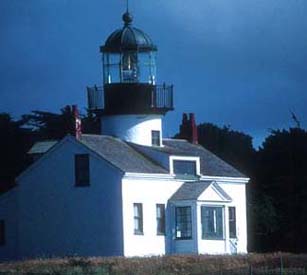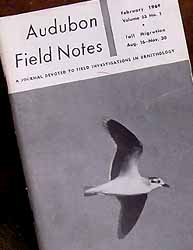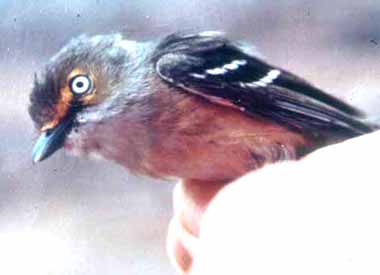1965
includes autumn 1964
 In the early 1960s, Guy McCaskie and Rich Stallcup had begun to discover
a few vagrant traps in coastal California. Guy had already discovered the
value of the Tijuana River Valley in San Diego Co., and Rich had already
visited outer Pt. Reyes in Marin Co. It was in fall 1964, however, that
soon-to-be famous inland locations like Deep Springs (above;
the tiny patch of green trees in otherwise desolate Deep Spring Valley,
Inyo Co.) and Furnace Creek Ranch (in Death Valley Nat'l Monument, Inyo
Co.) began to enter the literature. But the bird highlight of autumn 1964
was coastal: Guy McCaskie's discovery of a flock of Red-throated Pipits
in the Tijuana River Valley (TRV) on 12 Oct; Guy collected two specimens
as confirming evidence. Guy also had a Blue-winged Warbler (2d state
record), Gray Catbird (2d state record), Blackburnian Warbler
(2nd
state record) in the TRV. By winter 1964-1965, Guy was working the south
end of the Salton Sea, finding 2 McCown's Longspurs 30-31 Jan 1965.
In the early 1960s, Guy McCaskie and Rich Stallcup had begun to discover
a few vagrant traps in coastal California. Guy had already discovered the
value of the Tijuana River Valley in San Diego Co., and Rich had already
visited outer Pt. Reyes in Marin Co. It was in fall 1964, however, that
soon-to-be famous inland locations like Deep Springs (above;
the tiny patch of green trees in otherwise desolate Deep Spring Valley,
Inyo Co.) and Furnace Creek Ranch (in Death Valley Nat'l Monument, Inyo
Co.) began to enter the literature. But the bird highlight of autumn 1964
was coastal: Guy McCaskie's discovery of a flock of Red-throated Pipits
in the Tijuana River Valley (TRV) on 12 Oct; Guy collected two specimens
as confirming evidence. Guy also had a Blue-winged Warbler (2d state
record), Gray Catbird (2d state record), Blackburnian Warbler
(2nd
state record) in the TRV. By winter 1964-1965, Guy was working the south
end of the Salton Sea, finding 2 McCown's Longspurs 30-31 Jan 1965.
The major event in 1965 was the founding of Point Reyes Bird Observatory
(PRBO) on 1 March. It was the state's first full-time banding program.
It was spring 1965 when Rich Stallcup discovered that spring vagrants
used the same cypresses on outer Pt. Reyes as they did in fall;
on 6 June he had the first Pt. Reyes spring fallout: 2 Parulas, 2 American
Redstarts, a Northern Waterthrush, and Tennessee, Black-and-white, and
Magnolia Warblers. This revolutionized thinking about spring.
Autumn 1965 brought more surprises. PRBO caught & banded
its initial first state record (Black-billed Cuckoo on 22 Sep);
they would contribute many more first state records over time. They also
sent their first team of biologists to S.E. Farallon Island that fall.
Fall highlights in southern California included:
-
Guy McCaskie found first California record of Philadelphia Vireo
(9 Oct in TRV) and collected it
-
Guy discovered the first state record of Thick-billed Kingbird (19
Oct in TRV)
-
Gene Cardiff found a Rustic Bunting near Upland, Riverside Co.,
on 18 Nov; this would have been a state first but under the conservative
approach of the times, it was let go as "one that got away" since it was
not collected; details were not taken as, given these circumstances, they
were not then thought to matter
Guy McCaskie became the sole Regional Editor for "Southern Pacific Coast
Region" [=southern California] with the summer issue of Audubon Field
Notes. Prior to that he had been co-editor with Eleanor A. Pugh. |
|
1966
| The bird event of the year may have been an invasion of Snowy Owls
into northern California, beginning in December; the first records for
the state since 1916-1917. There was also a movement of pelicaniformes
to the Salton Sea during the summer, including 5 Blue-footed Boobies, a
Brown Booby, and a Magnificent Frigatebird (all by Guy McCaskie). Guy also
found a Buller's Shearwater at the Salton Sea on 6 August.
 Cypress
trees around the Pt. Pinos lighthouse (right), and around
adjacent Crespi Pond on the Monterey Peninsula, were discovered to be a
prime vagrant trap in fall. Local birders, including Alan Baldridge, Bill
Reese, Ron Branson & Vern Yadon, and visitors like Dave DeSante, found
several rarities there this autumn. Elsewhere in California, other noteworthy
species in 1966 included: Cypress
trees around the Pt. Pinos lighthouse (right), and around
adjacent Crespi Pond on the Monterey Peninsula, were discovered to be a
prime vagrant trap in fall. Local birders, including Alan Baldridge, Bill
Reese, Ron Branson & Vern Yadon, and visitors like Dave DeSante, found
several rarities there this autumn. Elsewhere in California, other noteworthy
species in 1966 included:
-
first Broad-winged Hawk in California; found & collected by
Guy McCaskie in the Tijuana River Valley 11 Dec
-
first Pine Warbler in California, found by Guy McCaskie in the TRV
22 Oct
-
first Grace's Warbler in California, found by Guy McCaskie in the
TRV 29 Oct
-
first northern California record of Painted Bunting, a first-year
male singing near Santa Rosa and collected by Gordon Bolander 24 June
-
first northern California record of Roseate Spoonbill since 1850,
found by Alan Baldridge & Bill Reese at Mendota NWR, Fresno Co.
-
2nd & 3rd state records of Thick-billed Kingbird, the second
found by Alan Craig at Pt. Loma 3 Dec, and the third found by Craig &
Art Wang at Bonita, San Diego Co., on 26 Dec
-
third state record of Prothonotary Warbler, found by Bruce Broadbooks
& Eleanor Pugh at Morro Bay SP, San Luis Obispo Co., 2 Oct.
|
|
1967
 The discovery that the Farallon Islands (above), 23 miles
west of San Francisco, were a major landbird vagrant trap highlighted this
year. Yes, Townsend had shot a Gray Catbird there in Sep 1884, and Dawson
had collected a Black-throated Green Warbler in May 1911, but its vast
potential had lain untapped for over half a century. The first spring visit
by PRBO biologists was during 7-14 June, but that fall, between 20-25 Sep,
Rich Stallcup, C.J. Ralph & Henry Robert encountered "the most spectacular
land bird migration 'wave' ever recorded in the Region." They recorded
118 species, including California's first Great Crested Flycatcher (two
on 25 Sep).
The discovery that the Farallon Islands (above), 23 miles
west of San Francisco, were a major landbird vagrant trap highlighted this
year. Yes, Townsend had shot a Gray Catbird there in Sep 1884, and Dawson
had collected a Black-throated Green Warbler in May 1911, but its vast
potential had lain untapped for over half a century. The first spring visit
by PRBO biologists was during 7-14 June, but that fall, between 20-25 Sep,
Rich Stallcup, C.J. Ralph & Henry Robert encountered "the most spectacular
land bird migration 'wave' ever recorded in the Region." They recorded
118 species, including California's first Great Crested Flycatcher (two
on 25 Sep).
Meanwhile, on the mainland, Alan & Jean Craig banded over 2000 migrants
in their Pt. Loma yard, and Guy McCaskie's coverage of the Salton Sea
produced the 2nd & 3rd state records of Semipalmated Sandpiper during
the spring. During the summer he found a Black-legged Kittiwake,
and Gene Cardiff collected the first inland records of Heermann's Gull
there.
The "bird of the year" was a Wandering Albatross that landed
on a flat bluff at Sea Ranch, Sonoma Co., 11 July (Rex Hardy). This was
the first record for the north Pacific but was not a 'chaseable' vagrant.
Like several extraordinary seabirds years later, this adult female was
likely searching for suitable nesting sites an ocean away from the species'
usual haunts. Another seabird of note was a live Horned Puffin seen
on Monterey Bay 6 June (Alan Baldridge), the first live one to be seen
by birders.
Fall 1967 brought several highlights:
-
first state record of Wood Thrush, found in the Tijuana River Valley
18 Nov by Guy McCaskie, while birding there with Cliff Lyons, Alan Craig,
and Pierre Devillers
-
second California record of Cerulean Warbler, found by McCaskie
on Pt. Loma 26 Oct
-
first northern California record of Philadelphia Vireo, found by
Rich Stallcup at Fairhaven, Humboldt Co., 16 Sep
-
third state record of Yellow-green Vireo, found by McCaskie in the
TRV 23 Sep
-
fourth state record of both Scarlet Tanager & Canada Warbler
in the TRV
|
|
1968
In 1968, PRBO initiated full spring and fall coverage on S.E. Farallon
I., a long-term commitment that continues today. McCaskie was now birding
the Salton Sea regularly, sometimes joined by Gene Cardiff, where there
were Blue-footed Boobies and a Magnificent Frigatebird again. He also surveyed
various Death Valley spots regularly, and had a Mississippi Kite
at Furnace Creek on 2 June. A highlight of the spring was Lee Jones's discovery
of Whip-poor-will singing in the San Jacinto Mts. 2 May, a first
for California. In northern California, Rich Stallcup found a Black-headed
Gull in Larkspur, Marin Co., 26 Apr (a second state record), but it
was not publicized until years later. Later, on 8 June, Alan Craig banded
the State's first Kentucky Warbler in his backyard on Pt. Loma,
San Diego.

It was another good fall on the Farallones; an Upland Sandpiper
there 22-24 Aug (Henry Robert) was the first in the state since 1896, and
northern California's first Red-throated Pipit was there 3 Nov.
Guy McCaskie spent a week there and found a Bay-breasted Warbler,
just the 2nd for northern California. Down in southern California, Alan
Craig banded a Grace's Warbler in his backyard on Pt. Loma, the
State's second record.
The overall fall highlight was a Little Gull found by Gene Cardiff
at Mecca, Riverside Co., on 14 Nov. It represented a first state record,
proved to be a chaseable vagrant, and Arnold Small's photo of the bird
made the cover of Audubon Field Notes (right).
Nationally, a bird club was founded by Jim Tucker in Austin, Texas,
which would in time evolve into the American Birding Association
(ABA). The first newsletter is a mimeographed 5-page bulletin called "The
Birdwatcher's Digest." The subscription rate is $3 per year. The top California
lists reported were by Joe Greenberg (426), Richard Russell (268), and
Wayne Tillay (260) but it was apparent that the actual leaders have not
yet joined the club. |
|
1969
What in retrospect were the "birds of the year" were not chaseable
vagrants, but grounded seabirds picked up by happenstance ashore: Wedge-rumped
Storm-Petrel in a Carmel backyard 21 Jan, and Kittlitz's Murrelet
on a Pt. Loma beach 16 Aug. Both were passed on to museums and became important
specimens.

At the Salton Sea, Guy McCaskie collected the state's first inland
Mew
Gull there 9 April. During the summer and fall, birders at the Salton
Sea tallied 30 Blue-footed and 8 Brown Boobies but, better yet was the
state's first White-rumped Sandpiper found by McCaskie & Cliff
Lyons at the north end 6 June (collected). On the Farallones, banders during
the summer recorded the first state records of White-eyed Vireo
(4 June; photo left by Henry Robert), Yellow-throated Warbler (12
July), and Field Sparrow (17 June) plus northern California's first
Yellow-throated
Vireo (12 June). The fall was just as impressive there, with first
state records of Cassin's Sparrow (23 Sep) and
Baird's Sparrow
(28 Sep). Never before, and never since, have five new California records
been found at the same spot within the span of four months.
In late fall Gene Cardiff collected southern California's first Northern
Shrike at Deep Spring 15 Nov, and Alan Craig banded the first southern
California Yellow-throated Warbler — a bird of the nominate race
— at Pt. Loma 15 Oct. A Yellow-throated Vireo, found by Gene Cardiff
in Riverside 5 Dec, wintered locally until March; the first of the species
to winter in the state.
The bird club started by Jim Tucker the year before now became the American
Birding Association (ABA) and their newsletter was renamed Birding
magazine. It was reported that California had the top Christmas Bird Count
with 217 species in San Diego. Many more Californians were now involved,
and Birding Vol. 1, No. 1 reports the state list at 510 species.
The top five California state listers were Guy McCaskie (467; 91% of the
total), Arnold Small (428), Joe Greenberg (426), Bruce Broadbooks (398),
and Herb Clarke (393). Percentage-wise, Californians took the top 4 slots
among all states. The editor opined: "It is obvious that the birders in
California mean business. Guy McCaskie has thrown out the challenge that
to know the birds of a state, one should have observed at least 80% of
the state's total possibilities within that state. He and his fellow birders
are a living example that it can be done — and with style." |
|